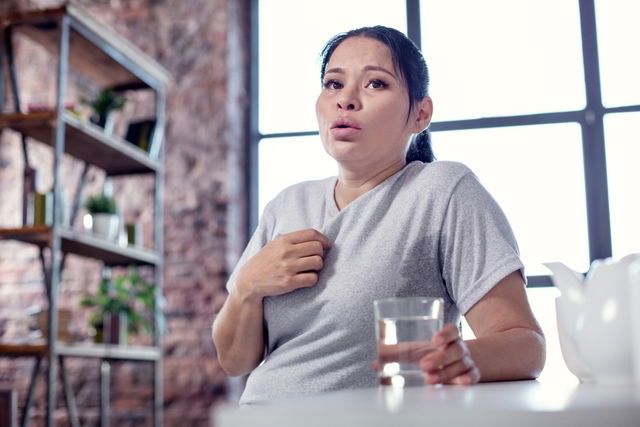In most cases, cold sweats are not a concerning symptoms. They can occur in stressful or dangerous situations, and resolve once the situation is resolved. However, cold sweats can be a sign of a health problem, like low blood sugar, low blood pressure, anxiety or shock.
If you experience this symptom frequently, or if the cold sweats you experience are very intense, you should see your doctor for assessment to see whether an underlying health issue is causing them. If a diagnosis is confirmed, appropriate treatment can be initiated.
What causes cold sweats?
The most common causes of cold sweats (and how to stop this symptom) are:

1. Low blood sugar
Low blood sugar, or hypoglycemia, is characterized by blood sugar levels that are below 70 mg/dl or 3 mmol/L. In addition to cold sweats, you may also experience headaches, fainting, blurred vision, confusion, weakness, general malaise, nausea or sleepiness.
To check your sugar levels, you can do a quick check with a glucometer (a small device that most insulin-dependent diabetics will have at home). Otherwise, you can proceed to your doctor’s office or nearest emergency room to check your levels.
How to stop it: If you experience any symptoms of hypoglycemia, you should eat something that is high in sugar and easy-to-digest carbohydrates, like fruit juice or a cookie. If symptoms persist even after eating, or if you faint, you should place some sugar under your tongue and seek medical attention immediately.
2. Low blood pressure
Low blood pressure, or hypotension, can lead to decreased oxygen to the brain and organs. It can cause cold sweats, dizziness, palpitations, weakness, blurred vision, general malaise, pallor and fainting. Learn more about the common symptoms of hypotension.
How to stop it: When experiencing low blood pressure, you should lie down with your legs elevated above your chest and increase your fluid intake.
3. Stress and anxiety
In stressful situations or during anxiety attacks, the body reacts by producing cold sweats that are mainly felt on the forehead, hands, feet and armpits. In addition to these symptoms, you may also experience muscle tension, general malaise, nausea, vomiting, palpitations and tremors. Learn more about what an anxiety attack feels like and how it is treated.
How to stop it: There are many ways you can control your anxiety, like getting a massage or taking a warm bath or drinking chamomile tea. Learn about other natural ways you can manage your stress or anxiety. In serious cases where you are unable to cope with your anxiety on your own, you should seek psychological therapy. Prescription medications may also be considered.
Severe anxiety attacks should be assessed in a hospital to rule-out the possibility of a heart attack, Learn more about the symptoms that are usually associated with a heart attack.
4. Decreased oxygen
Decreased oxygen, or hypoxia, can lead to decreased perfusion in the organs and tissues throughout the body. This can result in cold sweats, shortness of breath, weakness, confusion, and dizziness. Severe hypoxia can lead to loss of consciousness, and coma, which can be life-threatening. You should proceed to the hospital if you have symptoms of hypoxia.
Decreased oxygen can occur with poor circulation, accidental poisoning and standing in altitudes over 3000m. It can also occur in people with chronic lung issues or anemia. Shortness of breath that persist for too long can also lead to decreased oxygen levels. Learn more about what can cause shortness of breath.
How to stop it: Treatment usually consists of the use of an oxygen mask to regulate oxygen levels in the blood. The underlying cause of hypoxia should also be identified so that targeted treatment can be initiated, like nebulizers for asthma or antidotes for poisoning . Very severe cases will require artificial respiration.
5. Sepsis
Sepsis, or a systemic infection, is caused by a bacterial, viral or fungal infection that affects various organs in the body. It can lead to organ failure and make oxygenation difficult, resulting in cold sweats, high fever, tremors, low blood pressure or tachycardia.
How to stop it: Treatment for sepsis consists of the use of antibiotics, analgesics, anti-inflammatories and fluid replacement. If these interventions are not sufficient in clearing the infection, artificial respiration in the ICU may be necessary.
6. Shock
Shock, which can occur with profound trauma, injury, allergic reaction or in an accident, leads to a decrease of oxygen to the organs, resulting in decreased organ function. Common symptoms include cold sweats, pallor, increased heart rate, nausea, vomiting, weakness, dizziness or anxiety.
How to stop it: People in shock may or may not be conscious. In almost all cases, immediate medical attention is recommended. You should call an ambulance or proceed to the hospital for treatment as fast as possible.
